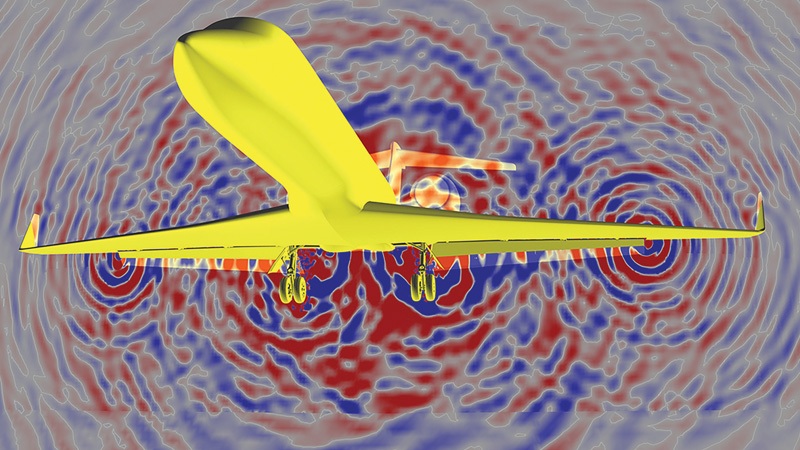Stay Up to Date
Submit your email address to receive the latest industry and Aerospace America news.
The Aeroacoustics Technical Committee addresses the noise produced by the motion of fluids and bodies in the atmosphere and the responses of humans and structures to this noise.
The understanding and reduction of radiated noise by aerospace flight vehicles is central to reducing developmental and operations costs within the military and commercial sectors in air and space.
The aeroacoustics research and development community made substantial efforts this year in pursuit of these goals.
The noise from military aircraft jet exhaust is an annoyance to the community and is harmful to military personal. Computational research groups at the Naval Research Laboratory of Washington, D.C., Purdue University and Craft Tech of Pennsylvania performed large eddy simulations with more complicated nozzle geometries and jet conditions closer to those of realistic jet engine exhausts. Additional computations involved the use of the immersed boundary method. Measurements of the aeroacoustic performance of multistream rectangular nozzles are underway at the universities of Texas and Mississippi to accompany the computational predictions. Similar jet exhaust experiments are being pursued at NASA Glenn Research Center in Ohio as part of a feasibility study for future supersonic airliners capable of meeting acceptable airport noise and sonic boom regulations.
Airframe noise simulations and predictions were conducted by NASA’s Langley Research Center in Virginia to evaluate several full-scale flap and landing gear noise reduction technologies.
Far-field noise data from a Gulfstream aircraft flight test were used to validate the computed solutions. UTC Aerospace Systems’ Aerostructures unit has started its ecoIPS program, which integrates a suite of nacelle system innovations bringing together the engine, nacelle system and pylon into a complete underwing package. The innovative technologies include a short fan duct with integrated thrust reverser to reduce drag as well as improved acoustic treatment for community noise reduction. The demonstration unit will be tested on a Pratt & Whitney PW1000G Geared Turbofan engine in 2019 under the FAA’s Continuous Lower Energy, Emissions, and Noise program.
NASA and Boeing are using large-scale Detached-Eddy Simulations to provide space-time coherence of surface pressures for structural-vibration predictions for NASA’s Space Launch System vehicle, SLS. The fluctuating forces created during ascent through the atmosphere produce an important design condition for launch vehicles. NASA’s Ames Research Center in California conducted a Buffet Verification Test in the 11-foot Unitary Plan Wind Tunnel in November 2015 using a generic model of a launch vehicle, fast response pressure sensitive paint and a large number of dynamic pressure sensors. The data collected from the test are now processed and used for computational validations. The University of Texas in Austin, in collaboration with NASA’s Marshall Space Flight Center in Alabama, completed a series of tests in August to quantify the acoustic loads that develop at the SLS launch pad. The measurements used four nozzles and focused on vibracoustic loads during nozzle startup and the effects of compliant nozzle walls on aero-elastic behavior. The findings are being used to develop a refined model of the launch pad environment that is expected to occur during startup of the SLS vehicle.
A consortium in Europe is performing comprehensive Research on Core Noise Reduction (the RECORD project). Leading engine manufacturers, research establishments and universities have joined forces to develop, validate and exploit methods for combustion noise prediction and control. An integrated approach is underway to understand noise sources from the combustor and their interaction with the turbine. Various numerical models from large eddy simulations to low-order physical models are applied to the reacting flow in a combustion chamber. The assessment of the achievements of RECORD is made by comparing these combustion noise calculations with existing real engine data. ★
Stay Up to Date
Submit your email address to receive the latest industry and Aerospace America news.




